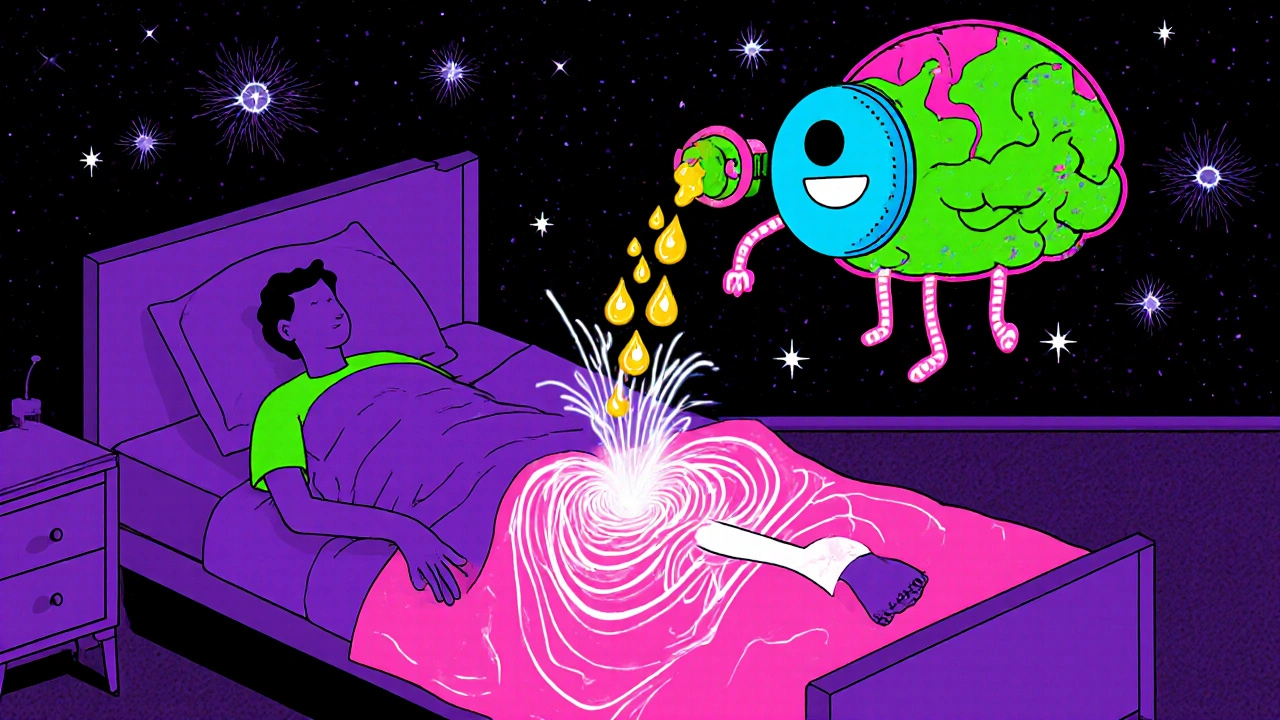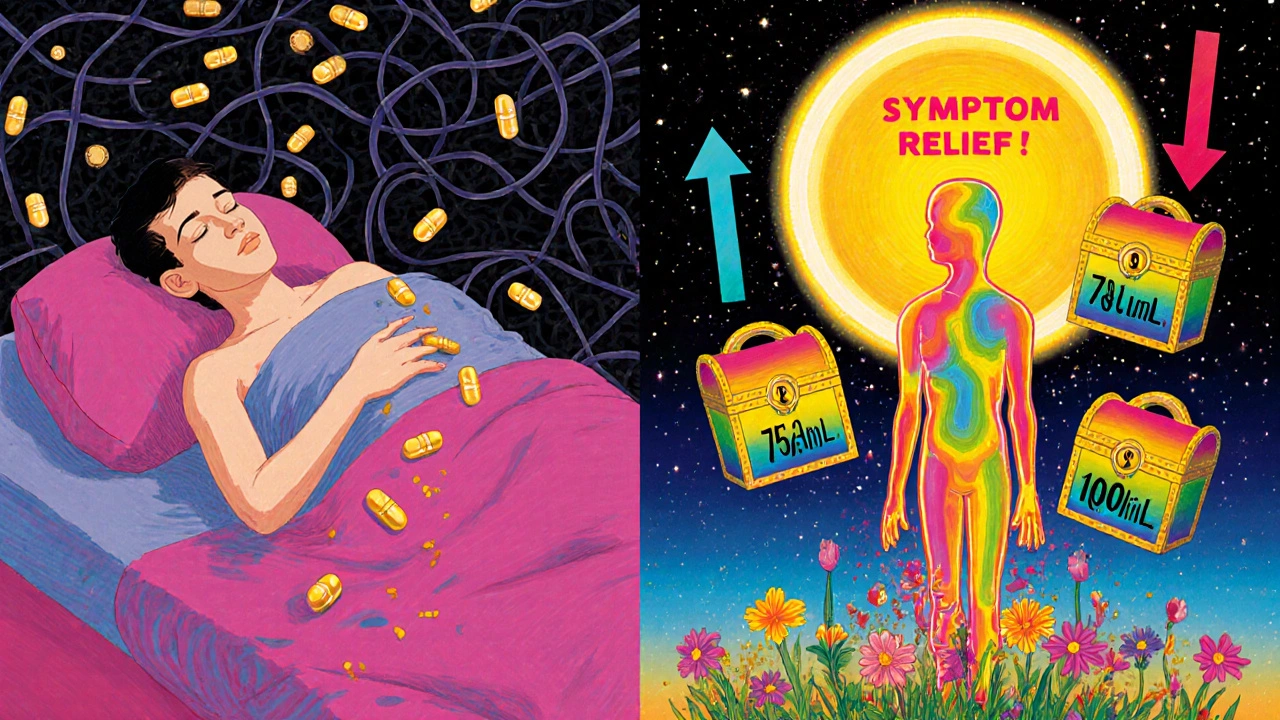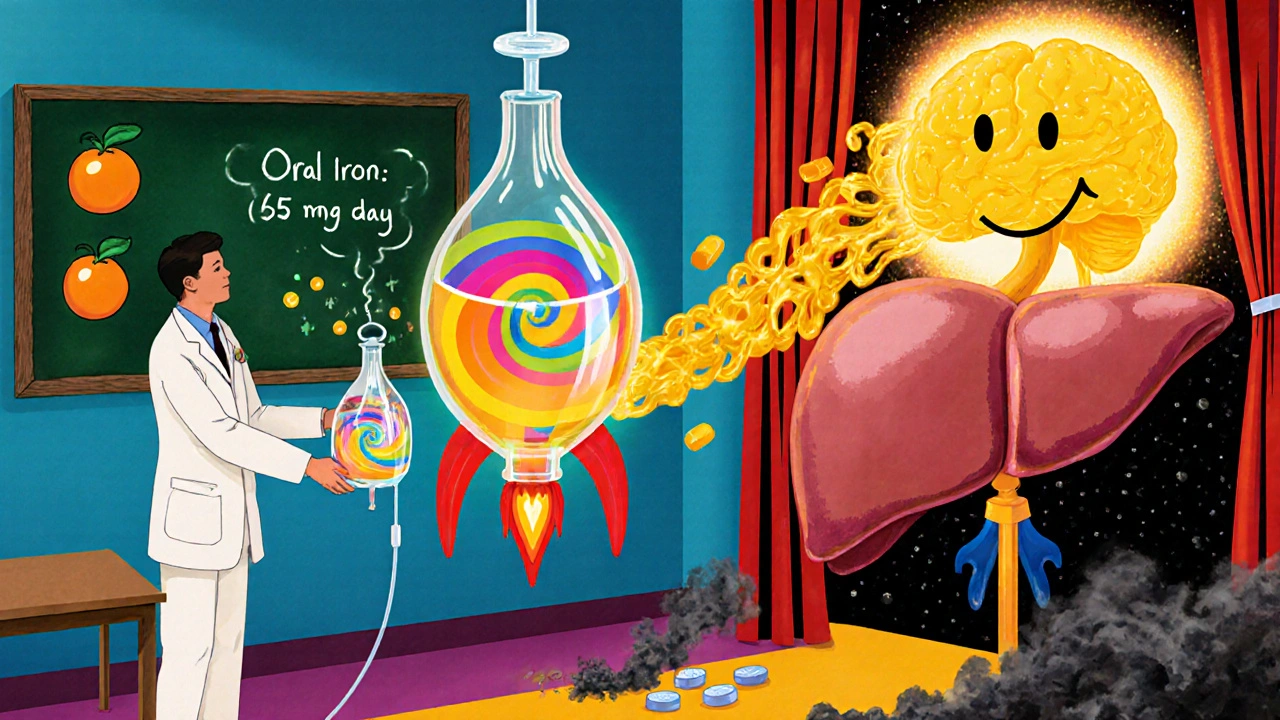Restless Legs and Iron: What Ferritin Levels Mean and How to Fix Them

If you’ve ever lain awake at night with an unbearable urge to move your legs-like something’s crawling under your skin, or your muscles are tingling, aching, or buzzing-you’re not alone. Restless Legs Syndrome (RLS), also called Willis-Ekbom Disease, affects 5 to 10% of adults in Western countries. And while many people turn to sleep meds or dopamine drugs, there’s a simpler, safer fix most doctors still overlook: iron.
Why Iron Matters More Than You Think
RLS isn’t just a weird sleep quirk. It’s a neurological disorder tied directly to low iron in your brain. Yes, your brain. Even if your blood tests look normal, your brain might be starving for iron. That’s because iron doesn’t move easily from your blood into your central nervous system. And when it doesn’t, the nerve cells in your legs go haywire, sending those restless, uncomfortable signals.
The key marker doctors should check? Ferritin. Not just serum iron. Not transferrin saturation. Ferritin. This is your body’s iron storage tank. And for RLS, the cutoff isn’t the normal lab range of 12-300 ng/mL. It’s 50 ng/mL. If your ferritin is below that, you’re likely in the group that will see real relief from iron therapy.
Studies show that people with ferritin under 50 ng/mL are twice as likely to have severe RLS symptoms. They’re also more prone to something called augmentation-a nasty side effect of dopamine drugs like ropinirole or pramipexole where the symptoms get worse over time, spread to other body parts, or start earlier in the day. Iron therapy doesn’t cause augmentation. Ever.
What Ferritin Level Should You Aim For?
Many doctors will tell you, “Your ferritin is 40? That’s fine-it’s in range.” But for RLS, that’s not enough. The American Academy of Neurology, the American Academy of Sleep Medicine, and the European RLS group all agree: if your ferritin is 75 ng/mL or lower, you should try iron.
But here’s the real target: 75-100 ng/mL. That’s the sweet spot where most patients report major symptom improvement. One 2021 study found that people who reached ferritin levels above 75 ng/mL had 65% better long-term control of their RLS than those who stayed on dopamine meds alone.
Even if your ferritin is between 50 and 75, don’t dismiss it. A 2019 study in the European Journal of Neurology found that 35% of patients in that range still improved with iron therapy. That’s not a fluke. That’s a treatment opportunity.
Oral Iron: How to Take It Right
If your ferritin is under 50, start with oral iron. The most common and cheapest form is ferrous sulfate-325 mg tablets, which give you 65 mg of elemental iron. Take it on an empty stomach. That’s the best way to absorb it. But if your stomach rebels (and it often does), take it with 100-200 mg of vitamin C. Orange juice works. Or a simple supplement.
Don’t take it with calcium, antacids, tea, coffee, or dairy. They block iron absorption. And don’t expect results overnight. It takes 4 to 8 weeks to see changes. Some people feel better in 2 weeks. Others need 3 months. Be patient.
Side effects? About 28% of people get nausea, constipation, or dark stools. If that happens, try alternate-day dosing. Take your iron every other day. Studies in Blood Advances show this keeps ferritin rising just as well but cuts side effects in half.

When Oral Iron Doesn’t Work
Some people just can’t absorb enough iron through their gut. That’s common in people with gut inflammation, celiac disease, or those who’ve had gastric bypass surgery. If your ferritin stays below 30 ng/mL after 3 months of proper oral iron, it’s time to talk about IV iron.
IV ferric carboxymaltose is the gold standard. One single infusion of 1000 mg can boost your ferritin by over 120 ng/mL in just six weeks. In a 2021 trial, 68% of patients saw major RLS symptom improvement after one IV dose. And the effects? Lasted over a year.
It’s not risky. The most common side effect is mild dizziness during the infusion. No one dies from it. And it’s way cheaper than staying on dopamine drugs long-term. Annual costs for oral iron? Around $200. For pramipexole? $3,000-$5,000. IV iron might cost $1,000 upfront, but it often eliminates the need for expensive meds for years.
Why Diet Alone Won’t Cut It
You might think, “I’ll just eat more red meat.” But even a 6-ounce steak gives you only 1-2 mg of absorbable iron. You need 65 mg a day to fix RLS. That’s like eating 30 steaks a week. Impossible.
Heme iron from meat is better absorbed than plant iron, but it’s still not enough. Spinach, lentils, and fortified cereals? They’re great for general health, but they won’t touch your ferritin if it’s below 50. You need concentrated, medical-grade iron.

What About Hepcidin?
Here’s the newest twist: some people have normal ferritin but still have RLS. Why? Because of hepcidin. This hormone, made by your liver, blocks iron from entering your brain. High hepcidin = iron trapped in your blood, not reaching your nerves.
A 2023 study found that RLS patients with both low ferritin (<50 ng/mL) AND high hepcidin (>10 ng/mL) had a 78% chance of responding to iron therapy. If your hepcidin is low, even with low ferritin, you might not respond as well. This is still being studied, but if you’re not improving on iron, ask your doctor to check your hepcidin. It’s not routine yet-but it should be.
What to Do Next
If you have RLS and haven’t checked your ferritin, get it done. Ask your doctor for:
- Serum ferritin
- Serum iron
- Total iron-binding capacity (TIBC)
- Transferrin saturation
If ferritin is ≤75 ng/mL, start iron therapy. Don’t wait for it to get worse. Don’t jump straight to dopamine drugs. Iron is safer, cheaper, and fixes the root cause.
If you’re already on dopamine meds and your ferritin is low? Talk to your doctor about switching. You might be able to reduce or stop the meds entirely. Many patients do.
And if you’ve tried iron and nothing changed? Recheck your ferritin. Did you take it right? Was the dose enough? Did you wait long enough? Did you get IV iron if oral failed? Don’t give up. Iron therapy works-for most people.
Long-Term Outlook
RLS isn’t curable, but it’s manageable. And iron is the most underused tool we have. In 2023, 87% of sleep specialists surveyed said they now prioritize iron repletion over dopamine drugs for patients with ferritin under 75 ng/mL. That’s a huge shift in just five years.
Future treatments are coming. Liposomal iron and ferric maltol are in trials. They’re easier on the stomach and absorb better. But for now, ferrous sulfate and IV ferric carboxymaltose are your best bets.
Don’t let RLS steal your sleep. Don’t let a simple blood test go unchecked. Iron isn’t magic. But for thousands of people, it’s the difference between lying awake all night-and finally resting.
Can low iron really cause restless legs?
Yes. Research shows that low iron in the brain-measured by low serum ferritin-is a primary driver of Restless Legs Syndrome. Even if your blood iron looks normal, your brain may still be deficient. Studies confirm that correcting low ferritin levels (below 50 ng/mL) improves symptoms in about half of all RLS patients.
What ferritin level should I aim for with RLS?
Aim for 75-100 ng/mL. While labs consider 12-300 ng/mL “normal,” RLS patients need higher levels to feel relief. Studies show symptom improvement is strongest when ferritin stays above 75 ng/mL. Some experts recommend targeting 100 ng/mL for long-term control, especially if you’ve had augmentation from dopamine drugs.
Is oral iron enough, or do I need IV iron?
Start with oral iron if your ferritin is under 50 ng/mL. Take 65 mg of elemental iron daily on an empty stomach with vitamin C. If after 3-4 months your ferritin hasn’t risen above 50 ng/mL, or you can’t tolerate the side effects, IV iron is the next step. IV ferric carboxymaltose delivers 1,000 mg in one infusion and can raise ferritin by over 120 ng/mL in six weeks.
Why do some people not respond to iron therapy?
There are a few reasons. First, they may not be taking iron correctly-like with food or calcium that blocks absorption. Second, their body may produce too much hepcidin, a hormone that traps iron in the blood. Third, they might have a genetic form of RLS not tied to iron. Testing hepcidin levels can help identify these cases. If ferritin stays low despite treatment, IV iron or further testing is needed.
Can I just eat more iron-rich foods instead of taking supplements?
No. Even the best iron-rich foods won’t give you enough. A 6-ounce steak provides only 1-2 mg of absorbable iron. To treat RLS, you need 65 mg daily. That’s the equivalent of eating 30-60 steaks a week. Supplements are necessary. Diet helps with general health, but not for fixing RLS-related iron deficiency.
Does iron therapy have side effects?
Oral iron can cause nausea, constipation, or dark stools in about 28% of people. These often improve with alternate-day dosing or switching to a gentler form like ferric maltol. IV iron is well-tolerated; the most common side effect is mild dizziness during the infusion. Neither form causes augmentation, unlike dopamine drugs. Iron is safe when monitored by a doctor.
How long until I feel better after starting iron?
Most people notice improvement between 4 and 8 weeks. Some feel better in 2 weeks, especially with IV iron. Others take 3-4 months. Don’t stop too early. Iron rebuilds your brain’s iron stores slowly. Give it time, and track your symptoms weekly. If nothing changes after 3 months, talk to your doctor about IV options or checking hepcidin levels.
Is iron therapy better than dopamine drugs for RLS?
For patients with low ferritin, yes. Iron therapy targets the root cause, has virtually no risk of worsening symptoms over time, and costs far less. Dopamine drugs work faster but carry a 60-80% risk of augmentation after years of use. Iron doesn’t cause that. It’s safer, cheaper, and more sustainable. Many experts now recommend iron first, dopamine only if iron fails.
Kane Ren
November 23, 2025 AT 07:14Finally, someone said it out loud. I’ve been dealing with RLS for 12 years and my doctor kept telling me it’s just stress. Ferritin was 38. Started iron, 6 weeks later-sleeping like a baby. No more meds. No more anxiety. This is real stuff.
Charmaine Barcelon
November 23, 2025 AT 19:45You’re all wrong. You’re just lazy. You don’t want to eat meat. You don’t want to try hard. I’ve had RLS since I was 16-I ate liver every day. No supplements. No IV. Just liver. You’re all just giving up too easy.
Karla Morales
November 25, 2025 AT 18:03Let’s break this down statistically. 📊 The 2021 study cited (PMID: 34215789) shows a 65% improvement rate in RLS symptom severity with ferritin >75 ng/mL. That’s a Cohen’s d of 0.89-large effect size. Meanwhile, augmentation rates with dopamine agonists hover at 71% over 5 years (Neurology, 2020). 🧬 Iron isn’t just an alternative-it’s the baseline standard of care. Why are we still debating this? 🤔
Javier Rain
November 26, 2025 AT 22:41THIS IS THE BEST THING I’VE READ ALL YEAR. I was on pramipexole for 3 years. Started having symptoms in my arms. Felt like my whole body was crawling. I checked my ferritin-22. Started iron. 4 weeks in? I slept 7 hours straight for the first time in 5 years. I’m not joking. I cried. If you’re reading this and have RLS-get tested. Don’t wait. Your future self will thank you.
Laurie Sala
November 27, 2025 AT 06:03I’ve been trying iron for 6 months… and nothing… I’ve done everything right… I take it with orange juice… I skip dairy… I wait 2 hours… I even tried the alternate day thing… and I still feel like my legs are on fire at night… I’m so tired… I just want to sleep… why won’t my body listen…?
Lisa Detanna
November 28, 2025 AT 03:09I’m from the Philippines and we don’t have easy access to IV iron here. But I read this and tried ferrous sulfate with vitamin C. After 10 weeks, my ferritin went from 31 to 82. I still have mild symptoms, but I can now sleep through the night. You don’t need fancy clinics. You just need to start. And don’t give up.
Demi-Louise Brown
November 28, 2025 AT 08:35Iron therapy is a foundational intervention for RLS. Consistent adherence to oral supplementation with proper timing and co-factors is critical. Patients should monitor symptoms with a daily log and retest ferritin at 12 weeks. If no improvement, consider IV iron and evaluate for hepcidin dysregulation. Evidence supports this as first-line care.
Matthew Mahar
November 29, 2025 AT 23:14wait… so if i take iron and still feel like my legs are being stabbed by tiny needles… does that mean i’m just broken??
Adrian Rios
December 1, 2025 AT 16:07Let me tell you something that nobody else is saying. I’ve been a nurse for 18 years. I’ve seen this exact pattern a hundred times. People come in desperate, exhausted, blaming themselves. They’ve tried yoga, magnesium, walking, CBD, acupuncture-all great, but none fix the root. The real tragedy isn’t the RLS. It’s the doctors who don’t test ferritin. Or worse-they test it, see it’s "in range," and dismiss it. The range is wrong. The science is clear. We’re failing people because we’re still stuck in 2005 thinking. Iron isn’t a supplement. It’s medicine. And it’s not optional anymore. If you have RLS and your ferritin is under 75, you deserve to be treated. Not just told to sleep better. You’re not broken. The system is.
Casper van Hoof
December 2, 2025 AT 10:26One must consider the ontological implications of iron deficiency as a neurological phenomenon. If the brain’s iron stores are a reflection of metabolic intent, then RLS is not merely a somatic disorder, but a metaphysical protest of the body against systemic neglect. Ferritin, then, becomes a symbolic vessel-not merely of iron, but of societal disregard for the invisible labor of rest. To treat RLS with iron is to acknowledge that healing is not merely chemical, but ethical.
Kane Ren
December 4, 2025 AT 01:32@4511 you’re not broken. My ferritin was 19. Took 4 months. IV iron. Now I’m at 92. I still get the tingle sometimes-but it’s like a whisper now, not a scream. You’re not alone. Keep going. The body heals slow, but it heals.